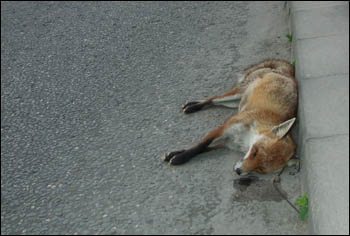
![]()
![]()

![]()
![]()
Finding Foxes
To find out if foxes are present in an area is a fairly simple task. You may find this out by looking for signs in the field or asking local landowners and farmers. Listening for fox calls at night is another way or simply waiting patiently to see them.
Looking for field signs: When looking for fox signs in any area, the four most important things are as follows:
These signs can be found almost anywhere, but the most likely places in a rural setting are along field margins and around rabbit warrens and woodland. Foxes tend to make regular paths alongside hedgerows and make their way along the edges of fields during winter months rather than crossing them, especially if land is ploughed. Rabbit warrens are marked with scats regularly.
Asking farmers and landowners: This is often a very effective way of finding out how common foxes are in local areas and can lead to direct observations of the animals. Farmers usually know where the breeding earths are and where to regularly catch sight of foxes travelling and hunting.
It is also a good idea to have the landowners' consent before walking on the land.
In urban or town areas it is best to ask night shift security guards and police officers about the whereabouts of any fox activity.
Listening for fox calls: This is best done at night, but is not always a suitable way of locating foxes as calls are more common at various times of the year and foxes seem to be more vocal in some areas than others. Nevertheless, at the right time of year it is an easy and effective method to find out if foxes are around, providing you don't mind patrolling fields or country lanes after dark.
When to listen: The first fox yells and barks for courtship can be heard in December, though they are few and far between.
Towards the end of January up until May, foxes can be heard barking regularly each evening as darkness falls. The bark can best be described as a "wow, wow, wow" sound.
As the night goes on, the calls are heard at less regular intervals. Quite often up to five or more individual foxes can be heard echoing across the countryside at the peak of vocal activity.
Direct observation: This comes last on the list for finding out if foxes are present. After hours of patient waiting, you want to have a guaranteed foxwatch, so it is best to do your research first.
Taking strolls at dawn or before dusk often reveals the whereabouts of foxes.
Food baiting an area regularly at night will eventually bring them to you. Almost any type of food will do, although it may also attract rats, cats, dogs or other animals instead of the fox, so again, it is best to look for signs beforehand to ascertain that foxes are in the area.
Road Kill: Road kill foxes can not only tell you that there are foxes in your area but can also show you the routes they travel through at that particular time of year and also sex and age of the fox. The most likely months for road kills are September (when young foxes are wandering and dispersing, particularly young males); December & January (the courtship season when there is a height of activity); Late spring (when there are young cubs wandering from the earth). Be careful not to get run over or cause an accident if you are looking at road kill foxes. Make sure it is safe to do so and also legal.
A dead fox is also a indication that the surrounding area might be a good place to watch, film and photograph foxes especially if there are good open fields around. A road killed young cub is a good clue that there is an active earth nearby so get searching.

Help reduce road kills - Attach wildlife warning
devices to your vehicle. Purchase on Amazon
![]()
![]()